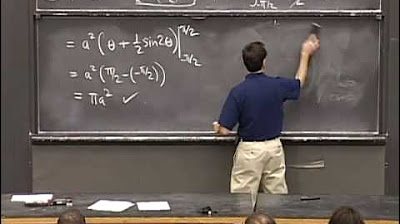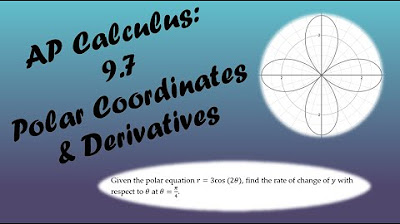Double Integrals in Polar Coordinates
TLDRThis script from Houston Math Prep offers a comprehensive tutorial on integrating double integrals using polar coordinates, focusing on the transition from rectangular (X, Y) to polar (R, Theta) coordinate systems. It explains the concept of 'polar boxes' for area approximation, deriving the formula for area in polar coordinates as R * dR * dTheta. The video demonstrates evaluating double integrals over specific regions, including the upper half of a unit circle and volumes between a paraboloid and the xy-plane, as well as between a cone and a plane, showcasing the practical application of polar coordinates in calculus.
Takeaways
- 📚 Integrating double integrals in polar coordinates involves using \( R \) for the radial distance from the origin and \( \theta \) for the angle of rotation from the positive x-axis.
- 🔍 The area element in polar coordinates is given by \( R \, dR \, d\theta \), which is derived from considering the area of a 'polar box' or sector of a circle.
- 📐 To find the area of a polar box, subtract the area of the inner circle (\( \pi (R - \Delta R)^2 \)) from the area of the outer circle (\( \pi (R + \Delta R)^2 \)) and simplify to get \( R \, \Delta R \, \Delta \theta \).
- 🧩 The formula for the area of a polar box, \( R \, dR \, d\theta \), is analogous to the rectangular coordinate area element \( dx \, dy \), but includes the radial distance \( R \) multiplied by the infinitesimal changes in radius and angle.
- 📉 When converting between polar and rectangular coordinates, remember that \( x^2 + y^2 = R^2 \) and \( x = R \cos(\theta), y = R \sin(\theta) \).
- 🔢 The double integral of a function over a region in polar coordinates is set up by first determining the bounds for \( R \) and \( \theta \) that define the region.
- 📈 For the example of the upper half of the unit circle, the integral of \( 1 - R^2 \) over the region is evaluated by integrating with respect to \( R \) from 0 to 1 and then with respect to \( \theta \) from 0 to \( \pi \).
- 🌀 The volume between the paraboloid \( Z = 4 - R^2 \) and the xy-plane is found by integrating the height function over the bounds of the circular base, which is a circle with radius 2.
- 📊 The volume calculation involves integrating the difference in heights (\( 4 - R \) and 5) over the region defined by the intersection of the cone and plane, which is a circle with radius 4.
- 📘 When dealing with volumes between two surfaces, the height function for the integral is the difference between the top surface function and the bottom surface function, evaluated over the region of interest.
Q & A
What is the main topic discussed in the video script?
-The main topic discussed in the video script is integrating double integrals using polar coordinates, specifically focusing on the concepts of R (radius) and theta (angle) in polar coordinate system.
What is the significance of R in polar coordinates as mentioned in the script?
-In polar coordinates, R represents the distance from the pole (or origin), and it is used to measure how far out from the origin a point is located.
What is theta in the context of polar coordinates?
-Theta represents the standard rotation from the positive x-axis in a counterclockwise direction in polar coordinates.
How does the script describe the process of setting up a double integral in polar coordinates?
-The script describes the process by first identifying the region of integration and then considering a small area element (or 'polar box') within that region. It explains how to calculate the area of this box using the formula R * ΔR * ΔΘ, where R is the radius at the center of the box, and ΔR and ΔΘ are the changes in radius and angle, respectively.
What is the formula for the area of a 'polar box' as explained in the script?
-The formula for the area of a 'polar box' is R * ΔR * ΔΘ, which simplifies to R * (R+ + R-) * (1/2) * ΔΘ, where R+ and R- are the outer and inner radii of the box, respectively.
How does the script simplify the formula for the area of a polar box?
-The script simplifies the formula by factoring the expression for the area as a difference of squares and then recognizing that the average of R+ and R- is the original radius R, resulting in the simplified formula R * ΔR * ΔΘ.
What is the unit of area used in polar coordinates for double integrals?
-The unit of area used in polar coordinates for double integrals is R * dR * dΘ, which accounts for the infinitesimal area elements as the number of polar boxes approaches infinity.
How does the script approach the evaluation of a double integral over the upper half of the unit circle?
-The script approaches the evaluation by setting up the integral with the correct bounds for R (from 0 to 1) and Θ (from 0 to π) and then integrating the function 1 - R^2 with respect to R first, followed by the integration with respect to Θ.
What is the final result of the integral over the upper half of the unit circle as given in the script?
-The final result of the integral over the upper half of the unit circle is π/4.
How does the script handle the conversion of Cartesian coordinates to polar coordinates for the purpose of integration?
-The script provides the conversions x = R * cos(Θ) and y = R * sin(Θ) for converting Cartesian coordinates to polar coordinates, which can be used when setting up integrals in polar coordinates.
What is the script's approach to finding the volume between the paraboloid Z = 4 - R^2 and the xy-plane?
-The script's approach involves setting up a double integral with the bounds for R from 0 to 2 (since the base is a circle with radius 2) and for Θ from 0 to 2π. The height function is 4 - R^2, and the integral is evaluated accordingly.
What is the final volume calculated between the paraboloid Z = 4 - R^2 and the xy-plane?
-The final volume calculated between the paraboloid Z = 4 - R^2 and the xy-plane is 8π.
How does the script determine the region of integration for the volume between the cone Z = 9 - R and the plane Z = 5?
-The script determines the region of integration by finding the intersection of the cone and the plane, which casts a circular shadow on the xy-plane with a radius of 4. The bounds for R are from 0 to 4, and for Θ from 0 to 2π.
What is the final volume calculated between the cone Z = 9 - R and the plane Z = 5?
-The final volume calculated between the cone Z = 9 - R and the plane Z = 5 is 64π/3.
Outlines
📚 Introduction to Double Integrals in Polar Coordinates
The script begins with an introduction to the concept of double integrals using polar coordinates. It explains the transition from rectangular (x, y) to polar (R, θ) coordinates, emphasizing how R represents the radial distance from the origin and θ represents the angular displacement. The script uses the analogy of a sector of a circle to illustrate how to calculate the area of an infinitesimal 'polar box', which is a small section of the area in polar coordinates. It simplifies the area calculation into a formula involving R, ΔR, and Δθ, leading to the integral expression R dr dθ for the unit area in polar coordinates when performing double integrals.
🔍 Evaluating Double Integrals in Polar Coordinates
This paragraph delves into the process of evaluating a double integral over a specific region using polar coordinates. It uses the example of the upper half of the unit circle and a function given in the integral. The script outlines the steps to set up the integral with the correct bounds for R (from 0 to 1) and θ (from 0 to π), and explains how to perform the integration with respect to R first, then θ. The result of the integral is calculated to be π/4, providing a clear example of how to apply the methodology in polar coordinates.
📏 Finding Volumes with Polar Coordinates: Paraboloid and XY-Plane
The script then discusses how to find the volume between the paraboloid Z = 4 - x^2 - y^2 and the XY-plane using polar coordinates. It starts by converting the equation of the paraboloid into polar form, Z = 4 - R^2, and identifying the region of integration as a circle with a radius of 2. The bounds for R are from 0 to 2, and for θ from 0 to 2π. The integral is set up with the height function and the extra R from the polar area element, resulting in the volume calculation. The final volume between the paraboloid and the XY-plane is found to be 8π.
📐 Volume Between a Cone and a Plane Using Polar Coordinates
The final paragraph addresses the calculation of the volume between the cone Z = 9 - √(x^2 + y^2) and the plane Z = 5. Recognizing the circular intersection of the cone and plane on the XY-plane, the script sets up the integral with the bounds for R from 0 to 4 and for θ from 0 to 2π. The height function for the volume calculation is the difference between the top surface of the cone and the plane. After integrating with respect to R and then θ, the script concludes with the volume of the solid between the cone and the plane, which is 64π/3.
Mindmap
Keywords
💡Polar Coordinates
💡Double Integrals
💡Sector
💡Radius (R)
💡Theta (θ)
💡Polar Box
💡Area Approximation
💡Volume Between Surfaces
💡Conversion from Rectangular to Polar
💡Unit of Area in Polar Coordinates
Highlights
Introduction to integrating double integrals using polar coordinates with R and theta instead of X and Y.
Explanation of R as the radial distance from the origin and theta as the standard rotation angle in polar coordinates.
Description of a 'polar box' as a small area element in polar coordinates for setting up double integrals.
Calculation of the area of a polar box using the difference of two circular sectors.
Derivation of the area formula for a polar box as R times Delta R times Delta Theta.
Conversion of the area element from rectangular to polar coordinates, introducing R dr d-theta.
Polar coordinate conversions: x^2 + y^2 = R^2 and x = R * cos(theta), y = R * sin(theta).
Example of evaluating a double integral over the upper half of the unit circle with the function 1 - R^2.
Integration methodology in polar coordinates, fixing the outer variable and integrating over the inner variable.
Calculation of the volume between the paraboloid Z = 4 - R^2 and the xy-plane using polar coordinates.
Setting up bounds for R from 0 to 2 and for theta from 0 to 2pi for the volume calculation of the paraboloid.
Integration of the volume between a cone Z = 9 - R and a plane Z = 5 using polar coordinates.
Determination of the intersection radius of the cone and plane as 4 for setting up the bounds of integration.
Final calculation of the volume between the cone and plane resulting in 64 PI / 3.
Emphasis on the importance of converting to polar coordinates for regions that are naturally round or circular.
Conclusion summarizing the process of integrating in polar coordinates and its practical applications.
Transcripts
Browse More Related Video

Lec 33 | MIT 18.01 Single Variable Calculus, Fall 2007

Polar Coordinates Basic Introduction, Conversion to Rectangular, How to Plot Points, Negative R Valu

Triple Integrals in Cylindrical Coordinates

Lesson 14 - Polar Equations (Calculus 2 Tutor)

Polar Coordinate System | Physics with Professor Matt Anderson | M3-02

AP Calculus BC Lesson 9.7
5.0 / 5 (0 votes)
Thanks for rating: